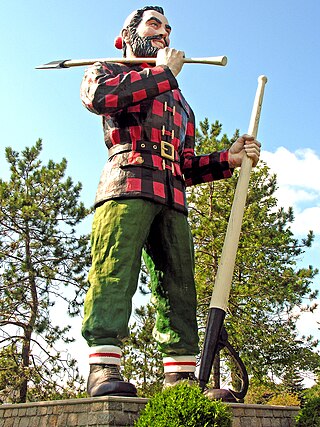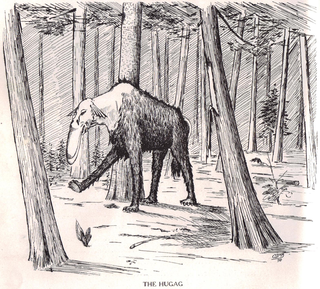Related Research Articles
American folklore encompasses the folklore that has evolved in the present-day United States mostly since the European colonization of the Americas. It also contains folklore that dates back to the Pre-Columbian era.

Paul Bunyan is a giant lumberjack and folk hero in American and Canadian folklore. His tall tales revolve around his superhuman labors, and he is customarily accompanied by Babe the Blue Ox, his pet and working animal. The character originated in the oral tradition of North American loggers, and was later popularized by freelance writer William B. Laughead (1882–1958) in a 1916 promotional pamphlet for the Red River Lumber Company. He has been the subject of various literary compositions, musical pieces, commercial works, and theatrical productions. His likeness is displayed in a number of oversized statues across North America.

Pecos Bill is a fictional cowboy and folk hero in stories set during American westward expansion into the Southwest of Texas, New Mexico, Southern California, and Arizona. These narratives were invented as short stories in a book by Tex O'Reilly in the early 20th century and are an example of American "fakelore". Pecos Bill was a late addition to the larger-than-life characters, such as Paul Bunyan or John Henry.

John Henry is an American folk hero. An African American freedman, he is said to have worked as a "steel-driving man"—a man tasked with hammering a steel drill into a rock to make holes for explosives to blast the rock in constructing a railroad tunnel.
A tall tale is a story with unbelievable elements, related as if it were true and factual. Some tall tales are exaggerations of actual events, for example fish stories such as, "That fish was so big, why I tell ya', it nearly sank the boat when I pulled it in!" Other tall tales are completely fictional tales set in a familiar setting, such as the European countryside, the American frontier, the Canadian Northwest, the Australian outback, or the beginning of the Industrial Revolution.

Tall Tale is a 1995 American Western adventure fantasy film directed by Jeremiah Chechik, written by Steven L. Bloom and Robert Rodat, produced by Walt Disney Pictures and Caravan Pictures and starring Scott Glenn, Oliver Platt, Nick Stahl, Stephen Lang, Roger Aaron Brown, Catherine O'Hara, and Patrick Swayze. It tells the story of a young farm boy who receives aid from tall tale figures in saving his town from a greedy developer.
Joe Magarac is a pseudo-legendary American folk hero. He is presented to readers as having been the protagonist of tales of oral folklore told by steelworkers in Pittsburgh, Pennsylvania, which later spread throughout the industrial areas of the Midwestern United States, sometimes referred to as the Rust Belt.

In North American folklore and American mythology, fearsome critters were tall tale animals jokingly said to inhabit the wilderness in or around logging camps, especially in the Great Lakes region. Today, the term may also be applied to similar fabulous beasts.

Paul Bunyan and Babe the Blue Ox are the names of a pair of large statues of the American folk hero Paul Bunyan and his ox, located in Bemidji, Minnesota. This roadside attraction has been listed on the National Register of Historic Places since 1988.

Charles "Cowboy" Morgan Evans was an American champion rodeo sports cowboy and oil field worker from Texas who worked as a rancher and oil drilling foreman the majority of his life.

Disney's American Legends is a 2002 American animated anthology film narrated by James Earl Jones. A compilation of four previously released animated musical shorts from Walt Disney Animation Studios based on American tall tales, the collection includes The Brave Engineer (1950), Paul Bunyan (1958), John Henry (2000), and The Legend of Johnny Appleseed which is a segment from the 1948 film Melody Time.
Febold Feboldson is an American folk hero who was a Swedish American plainsman and cloudbuster from Nebraska. His exploits were originally published in 1923 in the Gothenburg Independent newspaper and the character is now largely considered a part of fakelore as opposed to a genuine folk hero.
Tony Beaver is a character in several tall tales, often in tandem with stories of Paul Bunyan. Beaver was a West Virginian woodsman located up Eel River, often described as a cousin of Paul Bunyan, and champion griddle skater of the Southern United States. The stories appeared in print in the early 20th century and were later compiled by Mary E. Cober.

Invented traditions are cultural practices that are presented or perceived as traditional, arising from people starting in the distant past, but which are relatively recent and often consciously invented by historical actors. The concept was highlighted in the 1983 book The Invention of Tradition, edited by Eric Hobsbawm and Terence Ranger. Hobsbawm's introduction argues that many "traditions" which "appear or claim to be old are often quite recent in origin and sometimes invented." This "invention" is distinguished from "starting" or "initiating" a tradition that does not then claim to be old. The phenomenon is particularly clear in the modern development of the nation and of nationalism, creating a national identity promoting national unity, and legitimising certain institutions or cultural practices.
Quebec has a rich history of folklore.
Canadian folklore is the traditional material that Canadians pass down from generation to generation, either as oral literature or "by custom or practice". It includes songs, legends, jokes, rhymes, proverbs, weather lore, superstitions, and practices such as traditional food-making and craft-making. The largest bodies of folklore in Canada belong to the aboriginal and French-Canadian cultures. English-Canadian folklore and the folklore of recent immigrant groups have added to the country's folk.
Since the folkloric hero Paul Bunyan's first major appearance in print, the character has been utilized to promote a variety of products, locations, and services. The giant lumberjack's mass appeal has led him to become a recurring figure in entertainment and marketing, appearing in various incarnations throughout popular culture.
Harold William Felton was an American writer and folklorist, an author of many children's books and books of American tall tales, among others.

Ellen Stekert is an American academic, folklorist and musician. Stekert is a Professor Emerita of English at the University of Minnesota and a former president of the American Folklore Society.

Fabian "Joe" Fournier was a lumberjack, born in Quebec, who would later emigrate to the United States of America and work as a lumberjack in Michigan. He has often been said to be the man who inspired Paul Bunyan in at least some part.
References
- ↑ Folk-say: A Regional Miscellany, 1929–32, ed. Benjamin Albert Botkin, University of Oklahoma Press, 1930, Volume 2 pp. 382, 385
- ↑ Man, Bird, and Beast, Stith Thompson and James Frank Dobie, Texas Folklore Society 1926, Issues 5-7, p. 46
- 1 2 Brunvand, Jan Harold (1998). American folklore: an encyclopedia. Taylor & Francis. p. 1105. ISBN 978-0-8153-3350-0.
- ↑ Barr, Richard M. (16 October 1957). "A Rival For Paul Bunyan?". Tampa Bay Times, St. Petersburg, Florida. Retrieved 19 November 2021.
- ↑ Pelagri, Clarence (29 May 1976). "Gib Morgan: A Legend in American Folklore". Oil City Derrick, Oil City, Pennsylvania. Retrieved 19 November 2021.